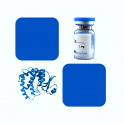
- Remove this product from my favorite's list.
- Add this product to my list of favorites.
Products
Newsletter
 |  |  |  |  |  |

Background
Hepatitis A virus cellular receptor 2 is also known as HAVCR2, FLJ14428, KIM3, TIM3, TIMD3, is a member of the TIM family of immune regulating molecules with one Ig-like V-type domain and a Ser/Thr-rich mucin stalk. CD4-positive T helper lymphocytes can be divided into types 1 (Th1) and 2 (Th2) on the basis of their cytokine secretion patterns. Th1 cells and their associated cytokines are involved in cell-mediated immunity to intracellular pathogens and delayed-type hypersensitivity reactions, whereas Th2 cells are involved in the control of extracellular helminthic infections and the promotion of atopic and allergic diseases. The 2 types of cells also cross-regulate the functions of the other. HAVCR2 is a Th1-specific cell surface protein that regulates macrophage activation and enhances the severity of experimental autoimmune encephalomyelitis in mice. HAVCR2 regulates macrophage activation. Inhibits T-helper type 1 lymphocyte (Th1)-mediated auto- and alloimmune responses and promotes immunological tolerance. May be also involved in T-cell homing. Dysregulation of the HAVCR2-galectin-9 pathway could underlie chronic autoimmune disease states in human, such as multiple sclerosis.
Source
Recombinant Cynomolgus TIM-3 / HAVCR2, Fc Tag (TI3-C525b) is expressed from human 293 cells (HEK293). It contains AA Ser 22 - Arg 201 (Accession # EHH54703.1).
Predicted N-terminus: Ser 22
Molecular Characterization
This protein carries a human IgG1 Fc tag at the C-terminus.
The protein has a calculated MW of 45.8 kDa. The protein migrates as 50-65 kDa under reducing (R) condition (SDS-PAGE) due to glycosylation.
Endotoxin
Less than 1.0 EU per μg by the LAL method.
Purity
>85% as determined by SDS-PAGE.
Formulation
Lyophilized from 0.22 μm filtered solution in Tris with Glycine, Arginine and NaCl, pH7.5. Normally trehalose is added as protectant before lyophilization.
Reconstitution
Please see Certificate of Analysis for specific instructions.
For best performance, we strongly recommend you to follow the reconstitution protocol provided in the CoA.
Storage
For long term storage, the product should be stored at lyophilized state at -20°C or lower.
Please avoid repeated freeze-thaw cycles.
This product is stable after storage at:
-20°C to -70°C for 12 months in lyophilized state;
-70°C for 3 months under sterile conditions after reconstitution.
Bioactivity
Please refer to product data sheet.
(1) "N-glycosylation reinforces interaction of immune checkpoint TIM-3 with a small molecule ligand"
Vergoten, Bailly
Comput Biol Chem (2023) 104, 107852
(2) "The combination of oxaliplatin and anti-PD-1 inhibitor promotes immune cells infiltration and enhances anti-tumor effect of PD-1 blockade in bladder cancer"
Zhao, Liu, Sun et al
Front Immunol (2023) 14, 1085476
(3) "Inhibiting efferocytosis reverses macrophage-mediated immunosuppression in the leukemia microenvironment"
Cruz Cruz, Allison, Page et al
Front Immunol (2023) 14, 1146721
Showing 1-3 of 2117 papers.
Welcome Login
Contact us
Follow us